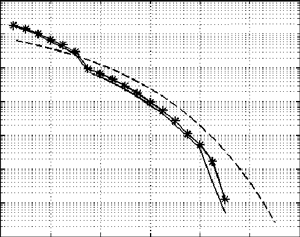Performance analysis of stack decoding on block coded modulation schemes using tree diagram
DOI:
https://doi.org/10.3103/S073527271208002XKeywords:
block coded modulation, stack decoding, Viterbi decoding, trellis diagram, asymptotic coding gainAbstract
The channel encoder adds redundancy in a structured way to provide error control capability. Modulator converts the symbol sequences from the channel encoder into waveforms which are then transmitted over the channel. Usually channel coder and modulator are implemented independently one after the other. But in a band limited channel better coding gains without sacrificing signal power are achieved when coding is combined with modulation. Block Coded Modulation (BCM) is such a scheme that results from the combination of linear block codes and modulation. In this paper we are proposing a stack decoding of rate 2/3 and rate 1/2 BCM schemes using tree structure and performance is compared with the Viterbi decoding that uses trellis representation. Simulation result shows that at reasonable bit error rate stack decoder performance is just 0.2 to 0.5 dB inferior to that of Viterbi decoding. Since stack decoding is a near optimum decoding scheme and whose decoding procedure is adaptable to noise level, we can consider this method in place of Viterbi decoding which is optimum and its decoding complexity grows exponentially with large code lengths.
References
A. G. Burr, “Block versus trellis: An introduction to coded modulation,” J. Electronics and Commun. Eng. 5, No. 4, 240 (Aug. 1993).
R. A. Carrasco and M. Johnston, Non-Binary Error Control Coding for Wireless Communication and Data Storage, 1st ed. (Wiley, 2009).
I. Hideki and Sh. Hirakawa, “A new multilevel coding method using error correcting codes,” IEEE Trans. Inf. Theory 23, No. 3, 371 (May 1977).
G. Ungerboeck, “Trellis Coded Modulation with ultilevel/Phase Signals,” IEEE Trans. Inf. Theory IT-28, 55 (Jan. 1982).
G. Ungerboeck, “Trellis Coded Modulation with Redundant Signal Sets. Part I: Introduction,” IEEE Commun. Magazine 25, 5 (Feb. 1987).
Sh. Lin and D. Costello, Error Control Coding, 2nd ed. Pearson Education, New Jersey, 2004).
T. K. Moon, Error Correction Coding (Wiley-Interscience, New York, 2006).
J. Wolf, “Efficient maximum likelihood decoding of linear block codes using a trellis,” IEEE Trans. Inf. Theory 24, No. 1, 76 (Jan. 2003).
A. Vardy, Trellis Structure of Codes, Handbook of Coding Theory (Elsevier Science, Amsterdam, 1998) [ed. by Vera Pless, W. Huffman, and R. A. Brualdi].
Sh. Lin, Kasami, Fujiwara, and Fossorier, Trellises and Trellis Based Decoding Algorithms for Linear Block Codes, 1st ed. (Kluwer Academic, 1998).
A. B. Kiely, S. J. Dolinar, R. J. McEliece, L. L. Ekroot, and W. Lin, “Trellis decoding complexity of linear block codes,” IEEE Trans. Inf. Theory 42, No. 6 (Nov. 1996).
R. Johannesson and K. Sh. Zigangirov, Fundamentals of Convolutional Coding (Universities Press, 2001).
A. J. Viterbi and Omura, Principles of Digital Communication and Coding, Int. ed. (McGraw-Hill, New York, 1979).


